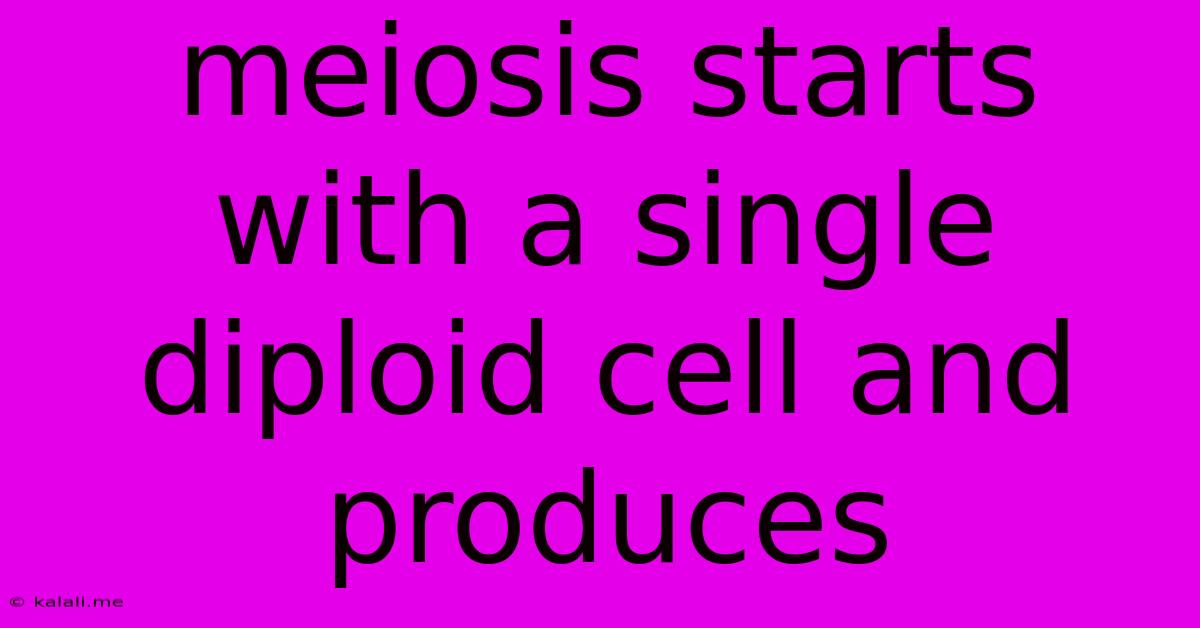Meiosis Starts With A Single Diploid Cell And Produces
Kalali
May 24, 2025 · 3 min read

Table of Contents
Meiosis Starts with a Single Diploid Cell and Produces Four Haploid Gametes
Meiosis is a specialized type of cell division that reduces the chromosome number by half, producing four haploid cells from a single diploid cell. This process is crucial for sexual reproduction, ensuring genetic diversity and maintaining the chromosome number across generations. Understanding the starting point and end result of meiosis is fundamental to grasping its significance in the life cycle of organisms.
What is a Diploid Cell?
A diploid cell contains two complete sets of chromosomes, one inherited from each parent. These sets are homologous, meaning they carry the same genes but may have different alleles (versions) of those genes. We represent the diploid chromosome number as 2n, where 'n' represents the number of chromosomes in a single set. For humans, n = 23, meaning our diploid number (2n) is 46.
The Process of Meiosis:
Meiosis is a two-stage process: Meiosis I and Meiosis II.
Meiosis I: Reductional Division
- Prophase I: This is the longest and most complex phase. Homologous chromosomes pair up, forming a structure called a tetrad. A critical event during this phase is crossing over, where non-sister chromatids exchange genetic material. This recombination shuffles alleles and contributes significantly to genetic variation.
- Metaphase I: Tetrads align at the metaphase plate, a central plane in the cell. The orientation of each tetrad is random, a process called independent assortment, which further increases genetic variation.
- Anaphase I: Homologous chromosomes separate and move to opposite poles of the cell. Sister chromatids remain attached at the centromere.
- Telophase I & Cytokinesis: The cell divides, resulting in two haploid daughter cells, each containing only one chromosome from each homologous pair.
Meiosis II: Equational Division
Meiosis II is similar to mitosis. It's a simpler process that separates sister chromatids.
- Prophase II: Chromosomes condense.
- Metaphase II: Chromosomes align at the metaphase plate.
- Anaphase II: Sister chromatids separate and move to opposite poles.
- Telophase II & Cytokinesis: The cell divides, resulting in four haploid daughter cells.
The Result: Four Haploid Gametes
The outcome of meiosis is the production of four haploid cells (n), each genetically unique due to crossing over and independent assortment. These haploid cells are called gametes: sperm in males and eggs in females. Importantly, these gametes each contain only one set of chromosomes.
The Significance of Meiosis:
The reduction in chromosome number from diploid to haploid is essential for sexual reproduction. When two haploid gametes (e.g., sperm and egg) fuse during fertilization, the resulting zygote is diploid (2n), restoring the original chromosome number. This cycle ensures that the chromosome number remains constant across generations. Furthermore, the genetic variation introduced through meiosis is the raw material for natural selection and evolution.
In Summary:
Meiosis begins with a single diploid cell (2n) and, through two rounds of division, produces four genetically unique haploid gametes (n). This process is crucial for sexual reproduction and the maintenance of genetic diversity within populations. The understanding of this fundamental biological process is vital in numerous fields, including genetics, evolution, and medicine.
Latest Posts
Latest Posts
-
How To Disconnect A Garbage Disposal
May 24, 2025
-
How Do You Freeze Dry Fruit
May 24, 2025
-
Can You Craft Ammo In Fallout 4
May 24, 2025
-
Can You Plug A Power Strip Into An Extension Cord
May 24, 2025
-
Are Angels On The Sample 3d Planes
May 24, 2025
Related Post
Thank you for visiting our website which covers about Meiosis Starts With A Single Diploid Cell And Produces . We hope the information provided has been useful to you. Feel free to contact us if you have any questions or need further assistance. See you next time and don't miss to bookmark.